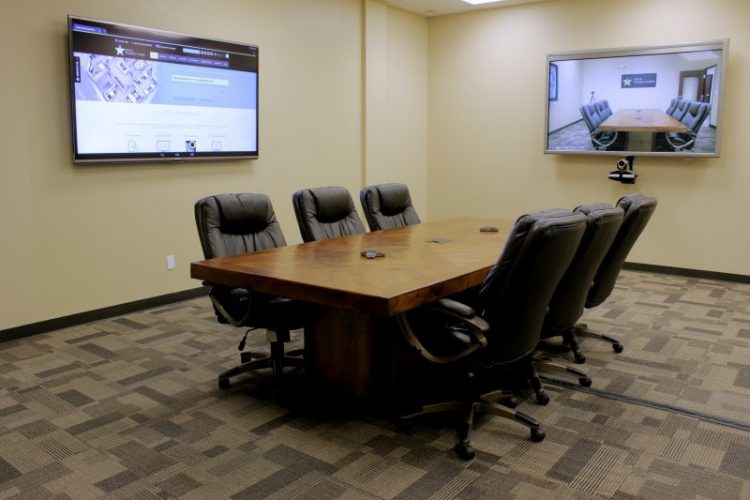[vc_row][vc_column][vc_column_text]Every video conferencing system relies on a combination of audio and video technology to deliver excellent call quality. The best video conferencing systems are also easy to use, loaded with features that improve the conferencing experience, and come with robust content sharing options.
It all starts with the technology, and this is what every video conferencing system needs:[/vc_column_text][vc_row_inner][vc_column_inner width="1/2"][vc_column_text css=".vc_custom_1595362843071{margin-bottom: 15px !important;}"]
A digital display
This display could be a desktop or laptop screen, but the most effective video conferencing systems use dedicated digital displays to provide high resolution video. Modern digital displays are made with LED technology, so they offer years of reliable performance. An AV integrator can help their clients size their displays so everyone involved can see them during a call.[/vc_column_text][/vc_column_inner][vc_column_inner width="1/2"][vc_column_text css=".vc_custom_1595362850733{margin-bottom: 15px !important;}"]
A camera
The camera could be something as simple as a webcam attached to the top of a laptop, or it could be something as sophisticated as an automated, face-tracking camera that’s integrated with the system. Ideally, the camera should be able to capture video at higher resolutions, pan around the room, and offer a wide-angle option if the room is packed.[/vc_column_text][/vc_column_inner][/vc_row_inner][vc_row_inner][vc_column_inner width="1/2"][vc_column_text css=".vc_custom_1595362856992{margin-bottom: 15px !important;}"]
Microphones
Good audio starts with a good microphone, and there are many options on the market. The best video conferencing system may be fitted with gooseneck microphones, boundary microphones or ceiling microphones. The right choice comes down to several factors, but gooseneck microphones tend to offer the best audio quality, ceiling microphones are the least conspicuous, and boundary microphones combine a compact build with strong audio quality.[/vc_column_text][/vc_column_inner][vc_column_inner width="1/2"][vc_column_text css=".vc_custom_1595362862935{margin-bottom: 15px !important;}"]
Speakers
In huddle rooms and smaller conference rooms, the display’s onboard speakers may be adequate. If external speakers are needed, they will be installed around the room to ensure everyone can hear at a comfortable volume.[/vc_column_text][/vc_column_inner][/vc_row_inner][vc_row_inner][vc_column_inner width="1/4"][/vc_column_inner][vc_column_inner width="1/2"][vc_column_text]
The codec is responsible for encoding and decoding audio and video data so it can be easily sent and received by the company’s network. odecs are categorized as either soft (as in, software-based) or hard (the codec is a separate piece of equipment).[/vc_column_text][/vc_column_inner][vc_column_inner width="1/4"][/vc_column_inner][/vc_row_inner][vc_column_text css=".vc_custom_1595363024974{margin-bottom: 15px !important;}"]These are the essential components, but the best video conferencing systems usually come with a couple more technologies, to facilitate better collaboration and call control. Here are a couple examples:[/vc_column_text][vc_row_inner][vc_column_inner width="1/2"][vc_column_text]
Room and integrated video conferencing systems are typically controlled with a touchscreen, so users can easily make calls, drop users and mute people. These touchscreens are vivid, so they can be used without being a distraction, and they are programmable, so an integrator can configure it for particular users or user groups.[/vc_column_text][/vc_column_inner][vc_column_inner width="1/2"][vc_column_text]
An interactive whiteboard or flat panel adds collaborative power to the meeting. With an interactive display, users can bring in photos or videos for example, write notes and annotate over media, or present and navigate through visually-compelling material. Modern interactive displays can be controlled by multiple users at once, which furthers collaborative efforts.[/vc_column_text][/vc_column_inner][/vc_row_inner][vc_column_text css=".vc_custom_1595364953901{margin-bottom: 15px !important;}"]
What are some of the best video conferencing system components?
The last few years have seen a surge in the number of video conferencing solutions available. Some of the best technologies, though, have come from established, respected names in the industry. Some of those technologies include:[/vc_column_text][vc_column_text]
Poly Studio X
The Poly Studio X is an all-in-one video conferencing solution, ideally suited for huddle rooms and smaller conference rooms. It’s designed for simple setup and configuration, so it can be easily scaled up and implemented immediately.
The Studio X is built with a face-tracking camera that detects who is speaking and frames them to preserve face-to-face communication. It’s also built with a microphone array that captures and delivers rich sound, so there’s no need for external speakers and microphones. The microphone array also utilizes Poly’s NoiseBlock, which detects background noise and instantly suppresses it to preserve the quality of the conversation. All that is needed is a display, and with the Studio X’s HDMI connectivity, it’s easy to find a display that will work with the system.
Wireless content sharing is also possible through the Studio X, through Miracast, Apple Airplay or through Poly’s own content sharing app. The system can also be paired with interactive whiteboarding technology to further enhance collaboration.
The Poly Studio X also comes with a native Zoom interface, so it fits easily into any workflow that leverages Zoom’s top-of-the-line conferencing technology.[/vc_column_text][vc_column_text]
Crestron Flex
The Crestron Flex is Crestron’s all-in-one conferencing and UC solution, and it is available in several series. The B-Series is of particular note, as it combines clear, high-quality audio with an integrated, intelligent camera. Like with the Poly Studio X, the Crestron Flex’s camera will track the speaker and frame them for a better conferencing experience.
The Crestron Flex can be designed for native compatibility with Microsoft Teams or Zoom Rooms, and it comes with a tabletop component for easy control. The tabletop screen allows for one-button calling, muting and content sharing, so it keeps the meeting moving along with minimal disruption.
The Flex can also be used with room scheduling systems. With room scheduling, the Flex allows managers to schedule meetings from a calendar, send an e-mail to everyone involved in the meeting and reserve a conference space ahead of time. The result is faster, more efficient meetings.[/vc_column_text][vc_column_text]Poly and Crestron offer some of the best video conferencing systems and are built for complex room layouts, offering a rich array of features that are compatible with a range of AV technologies and brands. The Poly Studio X and Crestron Flex offer the flexibility and functionality an enterprise organization would need (and want) from their technology.[/vc_column_text][/vc_column][/vc_row]



